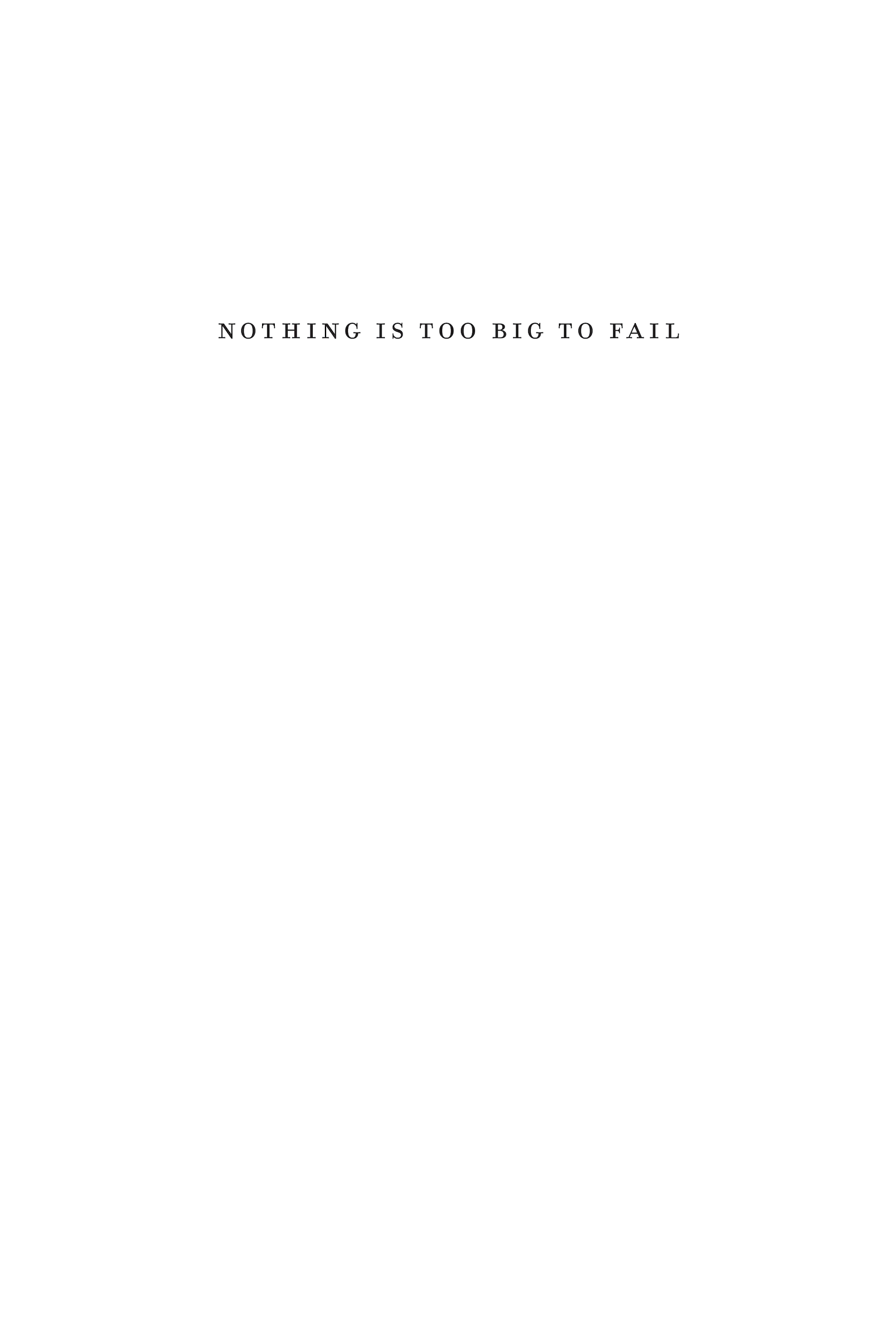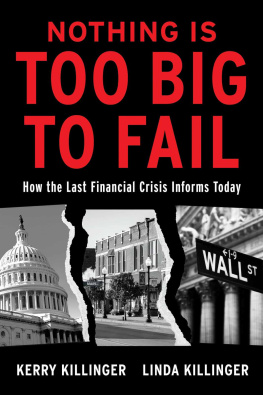Kerry Killinger - Nothing Is Too Big to Fail: How the Last Financial Crisis Informs Today
Here you can read online Kerry Killinger - Nothing Is Too Big to Fail: How the Last Financial Crisis Informs Today full text of the book (entire story) in english for free. Download pdf and epub, get meaning, cover and reviews about this ebook. year: 2021, publisher: RosettaBooks LLC, genre: Business. Description of the work, (preface) as well as reviews are available. Best literature library LitArk.com created for fans of good reading and offers a wide selection of genres:
Romance novel
Science fiction
Adventure
Detective
Science
History
Home and family
Prose
Art
Politics
Computer
Non-fiction
Religion
Business
Children
Humor
Choose a favorite category and find really read worthwhile books. Enjoy immersion in the world of imagination, feel the emotions of the characters or learn something new for yourself, make an fascinating discovery.
- Book:Nothing Is Too Big to Fail: How the Last Financial Crisis Informs Today
- Author:
- Publisher:RosettaBooks LLC
- Genre:
- Year:2021
- Rating:5 / 5
- Favourites:Add to favourites
- Your mark:
- 100
- 1
- 2
- 3
- 4
- 5
Nothing Is Too Big to Fail: How the Last Financial Crisis Informs Today: summary, description and annotation
We offer to read an annotation, description, summary or preface (depends on what the author of the book "Nothing Is Too Big to Fail: How the Last Financial Crisis Informs Today" wrote himself). If you haven't found the necessary information about the book — write in the comments, we will try to find it.
Kerry Killinger: author's other books
Who wrote Nothing Is Too Big to Fail: How the Last Financial Crisis Informs Today? Find out the surname, the name of the author of the book and a list of all author's works by series.
Nothing Is Too Big to Fail: How the Last Financial Crisis Informs Today — read online for free the complete book (whole text) full work
Below is the text of the book, divided by pages. System saving the place of the last page read, allows you to conveniently read the book "Nothing Is Too Big to Fail: How the Last Financial Crisis Informs Today" online for free, without having to search again every time where you left off. Put a bookmark, and you can go to the page where you finished reading at any time.
Font size:
Interval:
Bookmark:



Nothing Is Too Big to Fail
Copyright 2021 by Kerry Killinger and Linda Killinger
All rights reserved. No part of this book may be used or reproduced in any form or by any electronic or mechanical means, including information storage and retrieval systems, without permission in writing from the publisher.
For information, please contact RosettaBooks at , or by mail at 125 Park Ave., 25th Floor, New York, NY 10017
First edition published 2021 by RosettaBooks
Cover design by Mimi Bark
Interior design by Jay McNair
ISBN-13 (print): 978-1-9481-2276-4
ISBN-13 (ebook): 978-0-7953-5303-1
Library of Congress Cataloging-in-Publication Data
Names: Killinger, Kerry, author. | Killinger, Linda, author.
Title: Nothing is too big to fail : how the last financial crisis informs today / Kerry Killinger and Linda Killinger.
Description: First edition. | New York : RosettaBooks, 2021. | Includes bibliographical references and index.
Identifiers: LCCN 2020052416 (print) | LCCN 2020052417 (ebook) | ISBN 9781948122764 (hardcover) | ISBN 9780795353031 (ebook)
Subjects: LCSH: Global financial crisis, 2008-2009. | Banks and banking--Moral and ethical aspects--United States. | Monetary policy--United States. | Financial crises--United States. | Equality--United States.
Classification: LCC HB3717 2008 .K55 2021 (print) | LCC HB3717 2008 (ebook) | DDC 330.973/0931--dc23
www.RosettaBooks.com

Introduction
On a cold day in November 2009, Federal Reserve chair
Treasury Secretary Paulson in his 2010 book also shared a moment of remorse when he said, I see that, in the middle of a panic, [the seizure of Washington Mutual] was a mistake. As the sixth biggest bank in the country, it was systemically important.
Former New York Fed chair Geithner confessed in his book, We didnt examine the possibility that the initial fears associated with subprime mortgages and the fall in housing prices could trigger a classic financial crisis, followed by a collapse in the broader economy. He said he didnt require the banks he was overseeing to raise more capital because his staff didnt see a downturn coming.
These three officials may not have anticipated the financial crisis, but they cant say they werent warned. In the years before the crisis, a number of Nobel Laureate economists warned them about the exploding debt and asset bubbles growing in the economy. Other industry experts, including Kerry Killinger, warned Bernanke and others about the rising risks from an inflated housing market and the massive unregulated shadow subprime system and its heavy trillion-dollar tentacles fed by Wall Street. But Bernanke waved them all away with the statement, the Fed has the most sophisticated PhD economists in the world and we dont see a problem.
Bernanke, Paulson and Geithner continued to make rosy economic prognostications up until August, 2008 when they fell into a deep state of panic and stayed in that panicked state for a couple of years. Then their story kept changing.
In their latest book in 2020, First Responders, the three men now claim they knew there was a crisis coming, but they didnt have the tools and the powers they needed to fight the panic, nor was there an established playbook. Their book centered on how government can clean up the next crisis, but once again they failed to warn the public about todays growing asset and debt bubbles created by Fed policies. They forgot to mention that conditions are riskier today than they were before the 2008 financial crisis.
The financial crisis was not, as Bernanke claimed, a surprise event with macroeconomic forces that could not have been foreseen. The housing bubble, the subprime mortgage bubble, the Wall Street securitization bubble, and the credit default swap bubble were growing right there in plain sight.
The men who started and stoked the fires are now claiming to be firefighters and first responders, when in fact they were the arsonists. The 2008 crisis should not have happened and could have been contained if Bernanke, Paulson, and other policymakers would have listened and acted before 2008.
In 2007 and 2008, Congress, politicians, regulators, and the Federal Reserve, through inept policies and actions, turned a cyclical housing downturn into the worst financial crisis in nearly a century. Fed chair
In the bleak days at the height of the crisis, our elected and appointed officials turned finger pointing, coverups, and diversionary tactics into a cottage industry. Instead of learning from past mistakes and charting a new, safer course, leaders through overly expansive monetary policies and runaway federal budget deficits have now put us on a path toward a new financial crisis. We believe conditions are currently riskier than they were just prior to the last financial crisis. Our economy is highly leveraged, and negative shocks to the system could propel us once again into the abyss.
This book is about informing the American public about what really happened behind the scenes in the last financial crisis and pointing out what must be done today to prevent the next financial crisis.
Many popular books about the 2008 financial crisis have been written by self-aggrandizing bureaucrats, politicians, and regulators, all eager to justify their actions during the crisis they helped to create and failed to monitor effectively. Their books, such as Firefighting, Bull by the Horns, The Courage to Act, On the Brink, Stress Test, and First Responders positioned their authors as heroes, justified their lack of action before 2008, but sadly cast a blind eye toward how their actions helped cause the financial crisis. Many economic scholars have published their theories about the crisis, while some writers have authored tales long on drama and light on facts. Many important facts about the last financial crisis have not yet been revealed.
This is the first book to reveal the true behind-the-scenes reality of the 2008 financial crisis told from the perspective of a CEO heading up the sixth-largest bank in the country and his wife, a partner in an international accounting firm, who consulted with banks and thrifts for over twenty years. Washington Mutual was one of the first banks to be significantly impacted by the governments flawed response to the crisis.
Our readers will note throughout our book a shifting of voice from Linda to Kerry to the pronouns us or we. This reflects the fact that we both lived this experience; we both share an in-depth understanding of the US financial services industry, and our opinionsdiscussed and debated throughout the research and writing of this bookare united. We have made every effort to be candid and share the behind-the-scenes actions of regulators, politicians, investors, directors, and management.
The financial crisis could have been prevented but was fueled by blunders from the Federal Reserve and other regulators. We discuss how politicians fueled the housing bubble by demanding increased subprime lending, and we uncover the soft underbelly of the multimillion-dollar political contributions from the powerful megabanks.
Font size:
Interval:
Bookmark:
Similar books «Nothing Is Too Big to Fail: How the Last Financial Crisis Informs Today»
Look at similar books to Nothing Is Too Big to Fail: How the Last Financial Crisis Informs Today. We have selected literature similar in name and meaning in the hope of providing readers with more options to find new, interesting, not yet read works.
Discussion, reviews of the book Nothing Is Too Big to Fail: How the Last Financial Crisis Informs Today and just readers' own opinions. Leave your comments, write what you think about the work, its meaning or the main characters. Specify what exactly you liked and what you didn't like, and why you think so.







